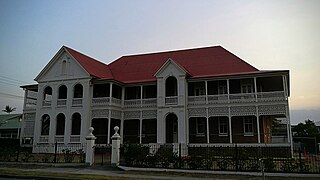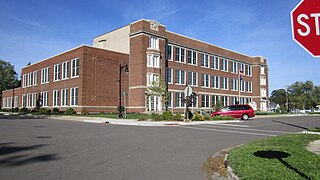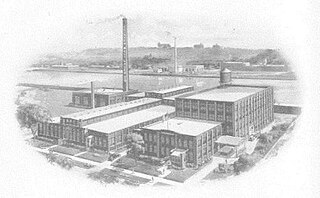
The Jefferson–Chalmers Historic Business District is a neighborhood located on East Jefferson Avenue between Eastlawn Street and Alter Road in Detroit, Michigan. The district is the only continuously intact commercial district remaining along East Jefferson Avenue, and was listed on the National Register of Historic Places in 2004.

St. Michael's Catholic Church is a parish of the Catholic Church in Spalding, Nebraska, part of the Diocese of Grand Island. It is noted for its historic buildings, notably the parish church, academy, and convent, which were added to the National Register as St. Michael's Catholic Church Complex in 1983.

The Chelsea Commercial Historic District is a historic district located along both sides of Main Street from Orchard to North Street in Chelsea, Michigan; the district also includes the adjacent 100 blocks of Jackson, East Middle, and West Middle Streets, as well as structures on Park, East, and Orchard Streets. It was listed on the National Register of Historic Places in 2011.

The Alma Downtown Historic District is a commercial historic district in Alma, Michigan, roughly located along Superior Street between the Pine River and Prospect Avenue, and along State Street between Center and Downie Streets. Parts of the district were designated a Michigan State Historic Site in 1975, and the entirety was listed on the National Register of Historic Places in 2013. It contains 72 structures, primarily brick commercial buildings, ranging from one to three stories in height and dating from 1874 to the 1960s.

Goldicott is a heritage-listed house, set on 1.23 hectares, located at 50 Grove Street, Toowong, Brisbane, Queensland, Australia. It was built from 1885 to c. 1918.

Mount Carmel Convent is a heritage-listed Roman Catholic former convent at 199 Bay Terrace, Wynnum, City of Brisbane, Queensland, Australia. It was designed by Hall & Dods and built in 1915 by William Richard Juster. It was added to the Queensland Heritage Register on 27 August 1999.

Our Lady of Assumption Convent is a heritage-listed former Roman Catholic convent at 8 Locke Street, Warwick, Southern Downs Region, Queensland, Australia. It was designed by Simkin & Ibler and built from 1891 to 1914. It is also known as Assumption College, Cloisters, and Sophia College. It was added to the Queensland Heritage Register on 21 October 1992.

Our Lady Star of the Sea Church & School is a heritage-listed Roman Catholic church and school at Goondoon Street, Gladstone, Gladstone Region, Queensland, Australia. It was built from 1924 to 1950. It was added to the Queensland Heritage Register on 21 October 1992.

The Range Convent and High School is a heritage-listed private school at 263 Agnes Street, The Range, Rockhampton, Rockhampton Region, Queensland, Australia. It was built from c.1880s to 1930s. It is also known as Our Lady of Good Counsel Convent and School and The Catholic College Residential. It was added to the Queensland Heritage Register on 21 October 1992.

All Hallows' School Buildings are a heritage-listed group of Roman Catholic private school buildings at 547 Ann Street, Fortitude Valley, City of Brisbane, Queensland, Australia. They were designed by a number of notable Brisbane architects and were constructed over many years. The earliest is the All Hallows Convent, also known as Adderton. The buildings were added to the Queensland Heritage Register on 21 October 1992.

Mercy Hospital and the Elizabeth McDowell Bialy Memorial House are two associated buildings located at 15th and Water Streets in Bay City, Michigan. They were listed on the National Register of Historic Places in 1980. As of 2018, the structures are operated as the Bradley House, a low income apartment complex.

The old Durand High School is a former school building located at 100 West Sycamore Street in Durand, Michigan. It was listed on the National Register of Historic Places in 2009. It has been refurbished into senior living apartments, known as the Sycamore House.

Villa Maria is a retirement community located at 1315 Walker NW in Grand Rapids, Michigan. The campus was originally operated for the purpose of ministering to troubled young women. It was listed on the National Register of Historic Places in 1987.

The Lofts Apartments, formerly known as the Medical Arts Building or the Becker Building, is an apartment building located at 26 Sheldon Boulevard SE in Grand Rapids, Michigan. The building was constructed as an office building in 1926, and was listed on the National Register of Historic Places in 2000.

The Monroe Avenue Water Filtration Plant is a municipal water treatment plant located at 430 Monroe Avenue NW in Grand Rapids, Michigan. Built in 1910, it was likely the first water filtration plant in Michigan. In 1945, the plant was the site of the first public introduction of water fluoridation in the United States. It was listed on the National Register of Historic Places in 2002. The building now serves as an event center, known as Clearwater Place.

Eastern Avenue School is a former public school building located at 758 Eastern Avenue NE in Grand Rapids, Michigan. It was listed on the National Register of Historic Places in 2013. As of 2018, the current owner plans to convert the building into apartments.

The Klingman Lofts is a former industrial building that has been converted to residential use, located at 400 Ionia Avenue SW, in Grand Rapids, Michigan. It was built in stages, beginning in 1895, as a furniture factory, and was formerly known as the Central Furniture Company Factory and the H.E. Shaw Furniture Company Factory. It was listed on the National Register of Historic Places in 2013. The building was renovated into apartment space in 2015.

The Old Grand Rapids Christian High School is a former private school building located at 415 Franklin Street SE in Grand Rapids, Michigan. The building was the original site of Grand Rapids Christian High School, which constructed the building in 1930. It was listed on the National Register of Historic Places in 2018. The building has been rehabilitated into a community and religious center known as 415 Franklin.

The Saint Joseph Seminary is a former Roman Catholic seminary building located at 600 Burton Street SE in Grand Rapids, Michigan. It was listed on the National Register of Historic Places in 2019.

The Clipper Belt Lacer Company Complex is a complex of seven former factory buildings located at 974-1010 Front Avenue NW in Grand Rapids, Michigan. It was listed on the National Register of Historic Places in 2023.






















